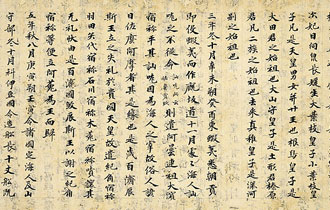Despite the fact that Oguchi was composing original pieces that combined festival music and jazz, Japanese and non-Japanese musical influences, Oguchi maintained that the music he and his group were playing was a revival of older festival music found in the Lake Suwa region; he also stated that it was the revival of the war drumming of Takeda Shingen, a sixteenth century
daimyō (warlord) who had ruled that region. It is difficult to either confirm or refute Oguchi’s claims of revival. Certainly, he based “Suwa Ikazuchi” on a found festival drumming fragment from the area, and drums did serve military purposes in Japan’s past, but this perspective ignores the contemporary performance elements brought in by Oguchi. Beyond the rhythmic and instrumentation changes made for Ōsuwa Daiko performances, Oguchi also brought many together many taiko in a single set to be played like a drum set, playing a role not unlike the one Oguchi would have behind a Western drum set in his light music band.
And yet, despite these apparent anachronisms, Oguchi would continue to advertise the status of Ōsuwa Daiko as “revival,” featuring old names for the region surrounding Lake Suwa on banners and performance garb. Further, the group would tap into elements of
Shintō ritual through the attachment of gohei,
Shintō paper offerings to the gods, to taiko, as well as the chanting of original norito,
Shintō chanting, during the performance of original songs. Regardless of the veracity of these connections to the past, they have proven to be influential, particularly on the context in which kumidaiko performance can be found. Today, groups can be found across Japan performing original compositions as part of festival activities on
Shintō shrine grounds alongside matsuri-bayashi ensembles playing older festival music. Taiko continue to have a place in festival settings, even if the music being played on the drums is changing.











